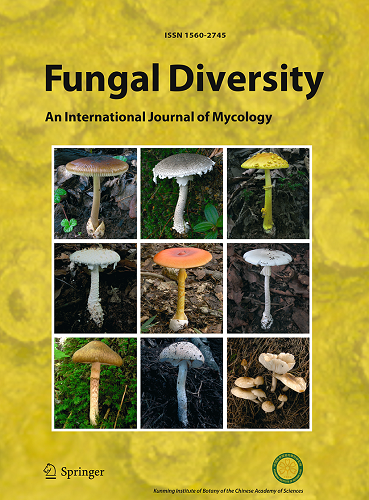具有多孔膜层的膜毛科植物的全球多样性和分类学
IF 24.8
1区 生物学
Q1 MYCOLOGY
引用次数: 42
摘要
基于最全面的系统发育分析,介绍了多孔膜壳科的分类和系统发育。基于已被接受的膜壳科属的ITS和nLSU序列的组合数据集,分析了膜壳科10个大属(包括Coltricia、Fomitiporela、Fomitaporia、Fulviformes、Fuscoporia、Inonotus、Phylloporia、Porodedalea、Sanghuanporus和Tropicporus)的大多数物种的两个或多基因系统发育。根据来自五大洲37个国家的样本,介绍了Meganotus、Neophellinus、Nothonotus、Pachynotus、Perenninotus、Pseudophylloporia和Rigidotous 7个新属,以及Coltricia tibetica、Fomitiporella crassa、F.queenslandica、Fomitoporia eucalypti、F.gatesii、F.ovoidospora、Fulviformes azonatus、F.caligoporus、F.costricense、F.floridanus、F.jouzaii 37个新种,F.nakasoneae、F.subindicus、Fuscoporia sinuosa、F.submurina、Inonotus subradiatus、I.vietnamensis、Neomensoria castanopsidis、Pachynotus punctatus、Phellinus cuspitatus、P.subellipsoideus、Phylloporia minutissima、P.tabernaemontanae、Porodedalea occidentamericana、P.orientoamericana和P.qilianensis、P.schrenkianae、Pseudophylloporia austraiana、Sanghuanporus austraianus,描述了S.lagerstroemiae、Tropicporus angustisulculatus、T.hainanicus、T.lineatus、T.minus、T.ravidus、T.substraticians和T.tenuis,并提出了108个新组合。此外,一个非法名称和两个无效名称被重新命名,Coltricia和Coltricella被同义。讨论了新分类群的分类相关性和局限性。展示了37个新物种的照片和插图,并对每个新物种进行了完整的描述。最终,本研究确认了34属672种,并为世界上多孔膜壳科的研究提供了一种现代处理方法。提供了一个膜壳科可接受的类孔属的检索表,并给出了全球32个类孔属可接受种的鉴定表。每个物种的简要描述都包含在这些钥匙中。本文章由计算机程序翻译,如有差异,请以英文原文为准。
Global diversity and systematics of Hymenochaetaceae with poroid hymenophore
Taxonomy and phylogeny of poroid Hymenochaetaceae based on the most comprehensive phylogenetic analyses are presented. A phylogeny based on a combined dataset of ITS and nLSU sequences for accepted genera of Hymenochaetaceae was analyzed and two or multigene phylogenies for most species of ten large genera including Coltricia, Fomitiporella, Fomitiporia, Fulvifomes, Fuscoporia, Inonotus, Phylloporia, Porodaedalea, Sanghuangporus and Tropicoporus, were carried out. Based on samples from 37 countries of five continents, seven new genera, Meganotus, Neophellinus, Nothonotus, Pachynotus, Perenninotus, Pseudophylloporia and Rigidonotus, are introduced, 37 new species, Coltricia tibetica, Fomitiporella crassa, F. queenslandica, Fomitiporia eucalypti, F. gatesii, F. ovoidospora, Fulvifomes azonatus, F. caligoporus, F. costaricense, F. floridanus, F. jouzaii, F. nakasoneae, F. subindicus, Fuscoporia sinuosa, F. submurina, Inonotus subradiatus, I. vietnamensis, Neomensularia castanopsidis, Pachynotus punctatus, Phellinus cuspidatus, P. subellipsoideus, Phylloporia minutissima, P. tabernaemontanae, Porodaedalea occidentiamericana, P. orientoamericana, P. qilianensis, P. schrenkianae, Pseudophylloporia australiana, Sanghuangporus australianus, S. lagerstroemiae, Tropicoporus angustisulcatus, T. hainanicus, T. lineatus, T. minus, T. ravidus, T. substratificans and T. tenuis, are described, and 108 new combinations are proposed. In addition, one illegitimate name and two invalid names are renamed, and Coltricia and Coltriciella were synonymized. The taxonomic relevance and limits of the new taxa are discussed. Photos and illustrations for 37 new species are presented, and a full description for each new species is given. Eventually, this study recognizes 672 species in 34 genera and provides a modern treatment of the poroid Hymenochaetaceae in the world. A key to the accepted poroid genera of Hymenochaetaceae is provided, and identification keys to the accepted species of 32 poroid genera worldwide are given. A synopsis description of each species is included in these keys.
求助全文
通过发布文献求助,成功后即可免费获取论文全文。
去求助
来源期刊

Fungal Diversity
生物-真菌学
CiteScore
44.80
自引率
9.90%
发文量
17
审稿时长
6 months
期刊介绍:
Fungal Diversity, the official journal of the Kunming Institute of Botany of the Chinese Academy of Sciences, is an international, peer-reviewed journal covering all aspects of mycology. It prioritizes papers on biodiversity, systematic, and molecular phylogeny. While it welcomes novel research and review articles, authors aiming to publish checklists are advised to seek regional journals, and the introduction of new species and genera should generally be supported by molecular data.
Published articles undergo peer review and are accessible online first with a permanent DOI, making them citable as the official Version of Record according to NISO RP-8-2008 standards. Any necessary corrections after online publication require the publication of an Erratum.
 求助内容:
求助内容: 应助结果提醒方式:
应助结果提醒方式:


